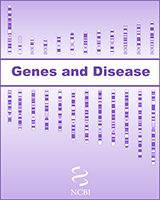NCBI Bookshelf. A service of the National Library of Medicine, National Institutes of Health.
National Center for Biotechnology Information (US). Genes and Disease [Internet]. Bethesda (MD): National Center for Biotechnology Information (US); 1998-.
Alpha-1-antitrypsin (AAT) is a protein that protects the body from damage by its immune cells. Deficiency of this protein leaves the lung, and occasionally the liver, vulnerable to injury.
The lung contains many tiny air sacs called alveoli. Oxygen travels across their walls into the bloodstream.

Lung alveoli
In AAT deficiency, the walls of the lung tissue (alveoli) are broken down. The result is a trapping of air known as emphysema. The damaged lung tissue can no longer transfer oxygen to the bloodstream.
White blood cells release elastase, a powerful enzyme that can fight infections. But it can also attack normal tissues. If uncontrolled elastase is released around alveoli, it would destroy their walls and surrounding tissue, leaving areas of trapped air. This abnormal accumulation of air in the lungs is called emphysema and causes shortness of breath.
AAT inhibits elastase around normal tissue. Deficiency is caused by mutations in the SERPINA1 gene, located on chromosome 14. This gene has many different versions (alleles) that produce different amounts of AAT. The M allele produces normal levels of the AAT protein, the S allele produces moderately low levels, and the Z allele produces very low levels.
The alleles are expressed in a codominant manner — that means that a person with MZ has levels of AAT that are between the levels of those people who have alleles MM or ZZ.
Individuals who have at least one normal allele (MZ or MS) or two copies of S (SS) usually produce enough AAT to protect the lungs but do have an increased risk of lung disease. The risk is particularly high if they smoke. Individuals who inherit the Z allele from each parent (ZZ) have very low AAT and are at a higher risk of developing emphysema and liver disease.
There are over 70 known mutations that occur at the SERPINA1 gene. A common mutation that creates the Z allele involves a switch in amino acids — glutamic acid is replaced by lysine at position 342 (Glu342Lys). The resulting AAT protein cannot fold properly. This hinders its secretion from the liver (which makes AAT) into the bloodstream (which transports AAT to the lungs). The accumulation of AAT complexes can damage the liver, whereas the lack of AAT fails to stop the destruction of lung tissue.
Treatment of AAT deficiency includes the standard treatment of emphysema (bronchodilators, early use of antibiotics in infections) as well as the more experimental therapies of correcting AAT levels by replacing the protein. Gene therapy to replace the defective SERPINA1 gene with a functional copy is currently being investigated.
However, the most important part of treatment of AAT deficiency is to avoid smoking. Affected individuals are far less likely to develop emphysema if they do not smoke. Not only is smoking a lung irritant, which attracts white blood cells (and therefore neutrophil elastase) to the lungs, it also prevents any AAT that is present in the lungs from working properly.
Related diseases
- Genome Data Viewer: SERPINA1 gene
- Entrez Gene collection of gene-related information
- GeneReviews a medical genetics resource
- Research articles online full text
- OMIM catalog of human genes and disorders
- MEDLINEplus Medical encyclopedia from the National Library of Medicine, NIH
- Patient information from National Heart, Lung and Blood Institute, NIH
- Alpha-1 Association information and patient support
- Alpha-1-antitrypsin deficiency - Genes and DiseaseAlpha-1-antitrypsin deficiency - Genes and Disease
- Fragile X syndrome - Genes and DiseaseFragile X syndrome - Genes and Disease
- PREDICTED: Cucurbita maxima 30S ribosomal protein S5, chloroplastic-like (LOC111...PREDICTED: Cucurbita maxima 30S ribosomal protein S5, chloroplastic-like (LOC111478601), mRNAgi|1280990378|ref|XM_023122965.1|Nucleotide
Your browsing activity is empty.
Activity recording is turned off.
See more...
